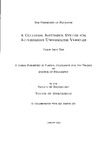A COLLISION AVOIDANCE SYSTEM FOR AUTONOMOUS UNDERWATER VEHICLES
| dc.contributor.author | TAN, CHIEW SEON | |
| dc.contributor.other | Faculty of Science and Engineering | en_US |
| dc.date.accessioned | 2013-10-21T12:01:16Z | |
| dc.date.available | 2013-10-21T12:01:16Z | |
| dc.date.issued | 2006 | |
| dc.identifier | NOT AVAILABLE | en_US |
| dc.identifier.uri | http://hdl.handle.net/10026.1/2258 | |
| dc.description.abstract |
The work in this thesis is concerned with the development of a novel and practical collision avoidance system for autonomous underwater vehicles (AUVs). Synergistically, advanced stochastic motion planning methods, dynamics quantisation approaches, multivariable tracking controller designs, sonar data processing and workspace representation, are combined to enhance significantly the survivability of modern AUVs. The recent proliferation of autonomous AUV deployments for various missions such as seafloor surveying, scientific data gathering and mine hunting has demanded a substantial increase in vehicle autonomy. One matching requirement of such missions is to allow all the AUV to navigate safely in a dynamic and unstructured environment. Therefore, it is vital that a robust and effective collision avoidance system should be forthcoming in order to preserve the structural integrity of the vehicle whilst simultaneously increasing its autonomy. This thesis not only provides a holistic framework but also an arsenal of computational techniques in the design of a collision avoidance system for AUVs. The design of an obstacle avoidance system is first addressed. The core paradigm is the application of the Rapidly-exploring Random Tree (RRT) algorithm and the newly developed version for use as a motion planning tool. Later, this technique is merged with the Manoeuvre Automaton (MA) representation to address the inherent disadvantages of the RRT. A novel multi-node version which can also address time varying final state is suggested. Clearly, the reference trajectory generated by the aforementioned embedded planner must be tracked. Hence, the feasibility of employing the linear quadratic regulator (LQG) and the nonlinear kinematic based state-dependent Ricatti equation (SDRE) controller as trajectory trackers are explored. The obstacle detection module, which comprises of sonar processing and workspace representation submodules, is developed and tested on actual sonar data acquired in a sea-trial via a prototype forward looking sonar (AT500). The sonar processing techniques applied are fundamentally derived from the image processing perspective. Likewise, a novel occupancy grid using nonlinear function is proposed for the workspace representation of the AUV. Results are presented that demonstrate the ability of an AUV to navigate a complex environment. To the author's knowledge, it is the first time the above newly developed methodologies have been applied to an A UV collision avoidance system, and, therefore, it is considered that the work constitutes a contribution of knowledge in this area of work. | en_US |
| dc.description.sponsorship | J&S MARINE LTD | en_US |
| dc.language.iso | en | en_US |
| dc.publisher | University of Plymouth | en_US |
| dc.title | A COLLISION AVOIDANCE SYSTEM FOR AUTONOMOUS UNDERWATER VEHICLES | en_US |
| dc.type | Thesis | |
| dc.identifier.doi | http://dx.doi.org/10.24382/1559 |
Files in this item
This item appears in the following Collection(s)
-
01 Research Theses Main Collection
Research Theses Main


